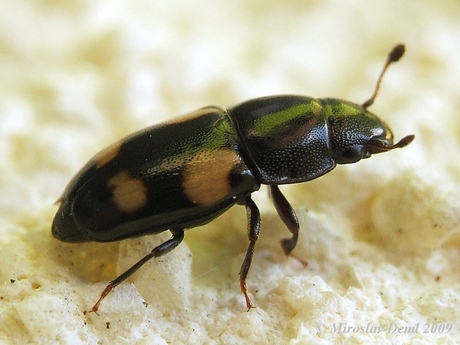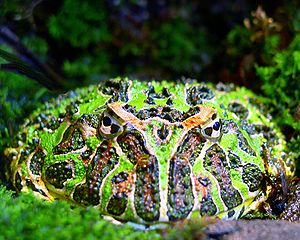Vacation feeders and “toys” for turtles…reptile care supplies certainly have come a long way since I started on my pet care and zoo-keeping career! Today I’d like to highlight two new automatic feeders designed especially for turtles (I believe both will be useful for African Clawed Frogs, Mexican Axolotls, newts and larger fishes as well). Exo Terra’s Automatic Feeder represents a great step forward in turtle care, allowing for 4 daily feedings of different foods over an extended period of time. The Zoo Med Floating Turtle Feeder, while not technically a “toy”, will keep you and your turtles entertained. Similar to behavioral enrichment tools and activities I employed at the Bronx Zoo, this feeder forces turtles to “work” for their meals, thereby encouraging activity and foraging behaviors. Read More »
Category Archives: Amphibians
Feed SubscriptionPoison Frogs – Sap Beetles as an Alternative Food for Small Frogs
Keepers of Poison Frogs, Mantellas, newly-transformed frogs, and other tiny amphibians face difficulties in providing their charges with a varied diet. Wild frogs consume dozens to hundreds of invertebrate species, but captives are usually limited to fruit flies, flour beetles, pinhead crickets and springtails. Vitamin/mineral supplements help, but dietary variety remains critical.
Throughout my career at the Bronx and Staten Island Zoos, I have relied heavily upon wild-caught invertebrates. I recently “re-discovered” an old favorite – the various Sap or Picnic Beetles (Family Nitidulidae). I first used Sap beetles when rearing Wood Frog metamorphs decades ago, and later fed them to Spring Peepers, Red-Eyed Treefrogs, Poison Frogs and others in zoo collections. Many small amphibians will eagerly gobble up Sap Beetles, but Poison Frog and Mantella keepers will find them especially useful. Sap Beetles never fail to bring an enthusiastic feeding response, and can save us some time and money while providing nutrients missing from standard foods.
Natural History
Sap Beetles are classified in the Family Nitidulidae, which contains nearly 3,000 members. Most top out at 1/8 inch, with the largest barely reaching ¼ inch in length. Several species, commonly known as “Picnic Beetles”, show up when sweet foods are served outdoors. Some feed upon over-ripe fruits, corn and other crops, while others take nectar, sap, fungi and carrion. Read More »
Amphibians as Pets – Common Frogs, Toads and Salamanders of the USA
This article covers the care of several native amphibians that live in close proximity to people. As a result, they sometimes wind up in yards, basements, window wells and other such places. Most are also seen in pet stores. While they can make interesting, long-lived pets, all have specific needs that must be met if they are to thrive. The following information will give you an idea of what is involved caring for amphibians as pets; please see the articles linked below for more detailed information, and post any questions you may have. If you find an injured animal, or wish to learn how to become a wildlife rehabilitator, please see this article.
It is important to bear in mind that captive-born specimens make far better pets than wild individuals, and that many species are protected by law. Read More »
Horned Frogs as Pets – Designing an Ideal Terrarium for “Pac Man Frogs”
The beautifully-colored and charmingly-pugnacious Argentine Horned Frog, Ceratophrys ornata, may be the world’s most popular amphibian pet. No matter how many rare and wonderful frogs I encounter, I always save a place for Horned Frogs in the zoo exhibits I manage and in my personal collection. Despite their size (females are often compared to salad bowls), Horned Frogs require relatively little living space. However, several important considerations must be kept in mind when setting up a Horned Frog terrarium. Once this has been accomplished, and if their other needs are met, you can look forward to a pet-keeping experience that may last for several decades. The following information can also be applied to the other Horned Frog species – there are 8 in all – that appear in the pet trade; please post below for more specific information on these.
Natural History
Argentine Horned Frogs inhabit seasonally-flooded grasslands, or savannas, in Argentina, Uruguay and Brazil (please see photo). Read More »
Keeping Frogs and Toads as Pets – Creating a Terrarium and Best Amphibian Care Products
From tiny “living jewels” to hulking giants capable of consuming bats, snakes and rodents, the world’s nearly 6,000 frog species present an amazing array of pet-keeping opportunities. With proper care, some may live for decades (to age 50 in the case of the African Bullfrog), and quite a few are active by day and quickly learn to accept food from one’s hand. However, keeping frogs and toads as pets means providing a habitat that meets their specific needs – humidity, temperature, substrate, terrarium size and shape, light, water quality and other conditions must be carefully considered.
Although each has needs that vary from those of others, some general rules have emerged. The following information is drawn from my experiences with hundreds of species over a lifetime of frog-keeping in zoos and at home. It can be applied to most of those that you are likely to encounter. However, details will vary – please post below for information concerning individual species.
Housing
Please remember that your frog’s natural history will dictate the type of terrarium it requires…please post below to discuss the need of individual species, or to share your observations.
Setting up the Terrarium
Active, sedentary, high-strung, aquatic, arboreal and terrestrial frogs and toads utilize their living spaces in different ways. Following are some basic guidelines for popular species. Read More »
 That Reptile Blog – Reptile, Amphibian and Exotic Pet Care and Information
That Reptile Blog – Reptile, Amphibian and Exotic Pet Care and Information




